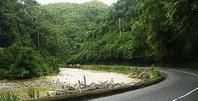Paul H.Williams, Sunday Gleaner Writer
The Rio Cobre meanders next to the main road in Bog Walk gorge. - Photo by Paul Williams
Three Saturdays ago, while talking with Devon McLaughlin, a Flat Bridge diver, about his heroic deeds, I couldn't help sensing the contradiction that surrounded me. I was in the beautiful Bog Walk gorge, fashioned by nature, but the stories of the tragedies that have unfolded in this river valley speak volumes of how devious it can be. As I was waiting for another diver to come along to tell his story, the sky suddenly got dark.
Devon asked me to wait a little while, but what he said to me about what happens in the vicinity of the bridge when it rains in that region was enough to tell me to go. Just as I got into the vehicle, the rain came, and to use a cliché, the rest was history: Almost seven days of rain and flooding, roadblocks and stranded passengers. The Rio Cobre, once again had shown its might.
Life sustainer
Rio Cobre, Spanish for Copper River, runs the entire length of the gorge. It is a major supplier of domestic water, and very popular with bathers. Fish and other aquatic creatures abound therein. In essence, it sustains life. Yet, it has taken many lives. According to Devon, when it puts on its 'brown suit', it will not stop until it is appeased with the taste of human flesh.
This legendary river is the setting for many folk tales, the most famous being The River Mumma and the Golden Table. It is the lure of the gorge; shallow and noisy in some areas, deep and silent in others. It rushes over and against rugged rocks, lazes around hairpin bends, and snakes through
interlocking spurs.
Steep limestone cliffs rise hundreds of feet into the rarefied air on either side. Etched in the cliffs on the northern side are small caves. Water seeps through their roof, and the roots of trees cling to their jagged surface. On the southern sides, the sheer drop of the mountainside is awesome, while in parts, huge blocks of ancient rocks are stacked one upon the other.
Famous rock
And talking about rocks, there's a famous one. A legend in its own right, travellers from near and far have been peeping into its gaping jaws for years. Its labial surface used to be wet and glossy, but the ravages of time have turned it greenish brown. Above it, and in the entire valley, the vegetation is lush.
From the elfin to the giant, the delicate to the hardy, the trees are varied. They are a part of the rich ecosystem that is the gorge. Egrets and other birds nest in some of the trees, dotting the green leaves with their white droppings.
The most famous man-made feature of the gorge is Flat Bridge. The original structure, made of wood, was washed away decades ago. The present structure, mounted on concrete columns, was designed by Thomas Lynch, also known as Buckra Lynch. It has been submerged by much flood waters over the years, but has survived them all.
A marker on one of the hillsides near the bridge shows where the Rio Cobre had swollen to 25 feet, in 1933. And so, it seems that the bridge is a willing assistant in satisfying the river's hunger for human life. Devon tells of vehicles, for no apparent reason, hurling themselves from the bridge into the waiting water.
It is this mixture of mystique and natural beauty that makes the Bog Walk gorge so enchanting. But, the temperamental Rio Cobre cannot be tamed. Watch as it races against time, almost awkwardly, but when it turns brown, beware; it's yearning for flesh.
paul.williams@gleamerjm.com

